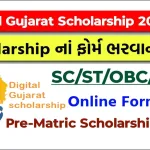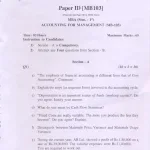Veer Narmad South Gujarat University (VNSGU) old question papers are a valuable resource for students preparing for exams. They provide insights into important topics, question formats, and frequently asked questions. This guide includes questions and answers from various subjects, helping students understand and prepare effectively for their exams.
Commerce
Question: What is meant by double-entry bookkeeping?
Answer: Double-entry bookkeeping is an accounting system where every transaction affects at least two accounts, with equal debits and credits.
Question: Define the term “working capital.”
Answer: Working capital is the difference between a company’s current assets and current liabilities, representing liquidity for day-to-day operations.
Question: What is the concept of marginal cost?
Answer: Marginal cost is the additional cost incurred when producing one more unit of a product or service.
Question: What is the importance of a ledger in accounting?
Answer: A ledger summarizes all transactions for each account, providing a clear picture of financial activities over time.
Question: Explain the term “depreciation.”
Answer: Depreciation is the reduction in the value of an asset over time due to wear and tear or obsolescence.
Question: What is the difference between fixed cost and variable cost?
Answer: Fixed costs remain constant regardless of output, while variable costs change directly with the level of production.
Question: Define the term “amortization.”
Answer: Amortization is the gradual repayment of a debt or allocation of the cost of an intangible asset over its useful life.
Question: What is a cash flow statement?
Answer: A cash flow statement shows the inflow and outflow of cash in a business over a specific period.
Question: What is the primary objective of financial accounting?
Answer: The primary objective of financial accounting is to provide financial information to stakeholders for decision-making.
Question: Explain the term “trial balance.”
Answer: A trial balance is a summary of all ledger accounts to ensure that debits equal credits in the accounting records.
Question: What are contingent liabilities?
Answer: Contingent liabilities are potential obligations that may arise in the future depending on certain events.
Question: Define the term “revenue.”
Answer: Revenue is the total income generated by a business from its primary operations before deducting expenses.
Question: What is the role of auditing in accounting?
Answer: Auditing ensures the accuracy and reliability of financial statements by examining financial records.
Question: What is the accounting equation?
Answer: The accounting equation is Assets = Liabilities + Owner’s Equity, representing the financial position of a business.
Question: Explain the concept of goodwill in accounting.
Answer: Goodwill is the intangible value of a business’s reputation, customer base, and brand recognition.
Question: What is the difference between gross profit and net profit?
Answer: Gross profit is revenue minus the cost of goods sold, while net profit is gross profit minus all expenses.
Question: What is the meaning of bank reconciliation?
Answer: Bank reconciliation is the process of matching a company’s bank statement with its accounting records to identify discrepancies.
Question: Define the term “provision” in accounting.
Answer: A provision is an amount set aside for a known liability or expense that will occur in the future.
Question: What is the accrual basis of accounting?
Answer: Accrual accounting records income and expenses when they are incurred, regardless of cash flow.
Science
Question: What is the law of conservation of energy?
Answer: The law of conservation of energy states that energy cannot be created or destroyed, only transformed from one form to another.
Question: Define Newton’s second law of motion.
Answer: Newton’s second law states that the force acting on an object is equal to its mass times its acceleration (F = ma).
Question: What is the pH scale?
Answer: The pH scale measures the acidity or alkalinity of a solution, ranging from 0 (acidic) to 14 (alkaline).
Question: What is the difference between speed and velocity?
Answer: Speed is the rate of motion without direction, while velocity includes both speed and direction.
Question: What is Ohm’s Law?
Answer: Ohm’s Law states that the current through a conductor is directly proportional to the voltage across it and inversely proportional to its resistance.
Question: What are isotopes?
Answer: Isotopes are atoms of the same element with the same number of protons but different numbers of neutrons.
Question: Define the term “ecosystem.”
Answer: An ecosystem is a community of living organisms interacting with their physical environment.
Question: What is the greenhouse effect?
Answer: The greenhouse effect is the trapping of heat in Earth’s atmosphere due to gases like carbon dioxide and methane.
Question: Explain the term “refraction.”
Answer: Refraction is the bending of light as it passes from one medium to another with a different density.
Question: What is the difference between mitosis and meiosis?
Answer: Mitosis is cell division resulting in two identical cells, while meiosis produces four genetically diverse gametes.
Question: What is the function of the heart in the human body?
Answer: The heart pumps blood throughout the body, delivering oxygen and nutrients and removing waste products.
Question: Define the term “photosynthesis.”
Answer: Photosynthesis is the process by which plants convert sunlight, carbon dioxide, and water into glucose and oxygen.
Question: What is the periodic table?
Answer: The periodic table is a chart organizing all known chemical elements based on their atomic number and properties.
Question: What are Newton’s three laws of motion?
Answer: Newton’s laws describe the relationship between a body and the forces acting upon it, explaining motion and inertia.
Question: What is the function of the nervous system?
Answer: The nervous system controls and coordinates body activities by transmitting signals between the brain and other parts of the body.
Question: What is the difference between a chemical reaction and a physical change?
Answer: A chemical reaction alters a substance’s composition, while a physical change affects its form without changing its identity.
Question: Define the term “density.”
Answer: Density is the mass of a substance per unit volume, commonly expressed as grams per cubic centimeter (g/cm³).
Question: What is the formula for calculating force?
Answer: Force is calculated using the formula F = ma, where F is force, m is mass, and a is acceleration.
Question: What is the function of chloroplasts in plant cells?
Answer: Chloroplasts contain chlorophyll and are the site of photosynthesis, where light energy is converted into chemical energy.
VNSGU old question papers provide an excellent way for students to familiarize themselves with exam formats and key topics. They also serve as a practical tool for self-assessment and improvement. By regularly practicing these questions, students can strengthen their understanding and boost their confidence for exams.
Latest Posts
- Step-by-step guide to download and apply for jee mains admit card 202
- Comprehensive 2025 government holidays and recruitment details for job seekers
- JEE Mains Admit Card 2025: Your Step-by-Step Guide to Downloading the Hall Ticket
- Everything You Need to Know About 2025 Government Holidays Recruitment
- Comprehensive Guide to rrb d group recruitment 2025 – Eligibility, Vacancies, and Application
- Detailed guide to nps trust recruitment 2025 vacancies, eligibility and apply process
- Comprehensive guide to hpcl recruitment 2025 notification, vacancies, and application process
- ignou bed admission 2025 complete recruitment guide with eligibility and process
- Comprehensive Guide to Indian Army Agniveer Recruitment 2025 Notification and Jobs
- Everything You Must Know About CBSE Board Exams 2025 Changes & New Rules





